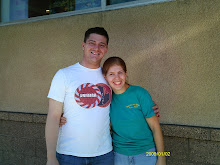Just before our hagwon's week-long summer vacation started, the teachers were informed that one of our part-time kindergarten staff members would not be at school for a week when we returned, due to a longer vacation time. This meant that we'd have to cover her class: Chinese.
"But I don't speak Chinese!" I nearly shouted at one of my co-teachers, incredulous.
"Don't worry about it," she said slowly. "We will not have Chinese class that week. Just we will do something for the class."
I was later handed a small slip of paper that denoted my time to substitute: second period on Tuesday the 3rd, with K-1. On the weekly schedule for that time slot, where the word "Chinese" used to be, was printed the opened-ended command, "Having Fun." What kind of fun was then left up to us. "I'm glad I wasn't given that [assignment]," an acquaintance of mine noted tongue-in-cheek today. "I would have said, 'Alright, kids, let's read 20 pages of The Economist.' "
I knew the class wasn't going to be the kind of fun my friend had mentioned, but neither would it be "fun-do-whatever." I was loathe to walk in without any real objective for the time I had; 40 minutes or not, the kids still needed some structure. I could always sing with them, I thought--but I have either a song-and-chant or musical-drama class with the kids one to two times a week. I didn't want another repeat of those, for fear of boredom in my regularly scheduled classes. Finally, it donned on me: Why not teach them to read music instead of just sing it? While I'm teaching them to read, there needs be a method for them to practice their skills--so why not an instrument, too?
I'll admit, I got a little carried away in my ambition; after all, this arrangement of extra time was for one week, not six. And they are kindergarteners, still lacking the finer motor skills which would allow them to complete such an endeavor successfully. I finally settled on a simpler approach: Don't worry about teaching them to read music. And don't worry about squawks and bloobles, either. Just introduce them to the idea that they might some day be able to play. It was settled, then--the very next day I would take my baby to school with me and together we would teach the kids about the art of making music.
I would first introduce the concept of music-making to the kids with a couple of etudes. Then I would introduce five of the basic notes and fingerings that I used. I would have the students finger them first on a pencil and then on the gem, my baby. If there were time, I even invented a game for the kids--tossing beanbags into bowls to symbolize which fingers to press on the keys or holes.
The class, I feel, was a rousing success! As soon as my baby and I started playing, virtually all of the kindergarten classes came to listen. As we settled into the bulk of the lesson, only four students remained and I was able to give them focused attention. I called them up front and each were able to not only blow into the clarinet, but actually produce the desired notes. One of my Korean co-workers later mentioned that the kids were so impressed. "Wow," they said. "I want to play an instrument like Jennifer Teacher!" My co-worker suggested that students like these, ones who attend English hagwons, don't really have a chance to try anything musical. She said it was good for the kids to at least be exposed to it. My baby and I had fun that day, for sure. Hopefully there can be a repeat performance in the near future.



No comments:
Post a Comment